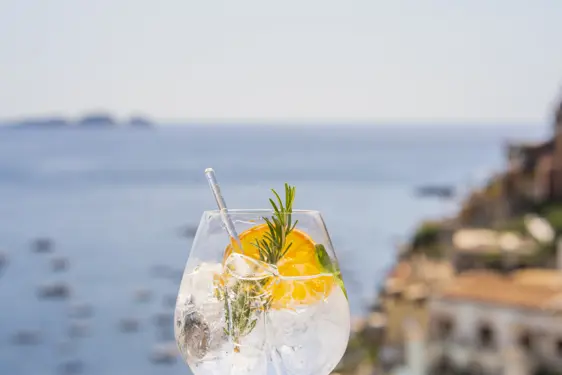GIN, TONIC & POSITANO
02.06.2022 RECIPES
The standard origin legend has it that it was British soldiers and civil servants in 19th-century India, then a part of the British Empire, who first popularized the drink as a way to make an unpleasant medicine more palatable. Quinine, a chemical compound first isolated in 1820 from the bark of the South American Cinchona tree, was known to be an effective cure for malaria. In 1854, a Scottish doctor called William Balfour Baikie discovered that it also worked as a preventative anti-malarial if taken regularly. There was only one problem: it was incredibly bitter. So, the story goes, it was mixed with sugar, soda water and a dash of gin to make it easier to swallow – and soon enough, what had begun as a medical cure caught on as a recreational drink.
It's a neat explanation – but as with many such foundation myths, it’s not entirely true. In their 2019 book Just the Tonic: A Natural History of Tonic Water, two researchers at the Royal Botanical Gardens in Kew, London, revealed that the story was most likely invented by conflating three separate facts. One is that, from the 1850s onwards, quinine was indeed often mixed with alcohol to make it more palatable – but in the British colonial services at this time, this was much more likely to be brandy, sherry, wine or rum. The second is that a taste for ‘gin and bitters’ – gin with a bittersweet mixer – was already well established in Britain: naval officers would for example mix Angostura bitters with gin to create a drink they called Pink Gin. And the final incontrovertible fact is that tonic water, as we know it today – a mix of soda water and quinine – was first patented in 1858 by a certain Erasmus Bond. However, the amount of quinine in Bond’s tonic water, or indeed in its modern equivalents, is around ten times less than the dose needed to effectively prevent malaria.
The true part of the origin story is that the habit of drinking gin with tonic was almost certainly born in British India – but as a refreshing cocktail designed to alleviate the tropical heat rather than a medical necessity. The earliest reference to the combination discovered by the book’s authors, Kim Walker and Mark Nesbitt, dates back to 1868, when it was among the drinks loudly called out for by attendees of a horse race in Lucknow.
Having debunked the myth, let us celebrate the mix.
THE PERFECT GIN & TONIC
- 5cl (1⅔oz) gin
- 10cl (3⅓oz) tonic water
- Ice cubes
- A slice of lemon or lime

View
Roberto Pane, head barman of Aldo’s at Le Sirenuse, recommends putting the gin in the glass first, then adding the ice and the lemon or lime, then pouring in the tonic. It’s as simple as that. The one-part-of-gin to two-parts-of-tonic ratio given here is perfect, Roberto says, for a pre-dinner aperitivo, but if you prefer a lighter drink, he recommends a one-to-three blend.
Which gin to use, and which tonic, are very much matters of personal taste. A classic combination served at Aldo’s pairs the London Dry Gin made by Winestillery in Gaiole in Chianti from a range of Tuscan botanicals with Fever Tree Premium Indian Tonic Water.
As for the lime or lemon debate, Roberto agrees that with its tropical tang, lime can be a good partner for certain gins, for example those with notes of coriander, ginger or spices. But for a classic, juniper-driven London gin, lemon is just as good a pairing, he believes “and on the Amalfi Coast, we have some of the best lemons in the world – so why not use them?”.
At Aldo’s, a range of gin and tonic variations include the Gin Mare pictured above, based on the Spanish gin of the same name whose key botanical is the arbequina olive. To this, Roberto adds Fever Tree Mediterranean Tonic Water, a slice of orange, a sprig of rosemary and a basil leaf to make a G&T “that expresses the spirit of the Mediterranean”. However, Le Sirenuse’s head barman has a word of advice for those starting to experiment with alternative gin and tonics: “First, never add any other spirits or cordials to the mix – otherwise it’s simply not a G&T. And second, go easy on the leaves, herbs and fruit: you want a gin and tonic, not a salad”.
Photos © Roberto Salomone
Le Sirenuse Newsletter
Stay up to date
Sign up to our newsletter for regular updates on Amalfi Coast stories, events, recipes and glorious sunsets



